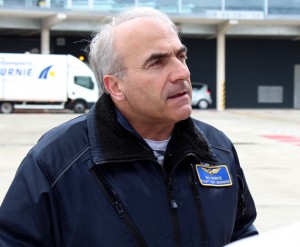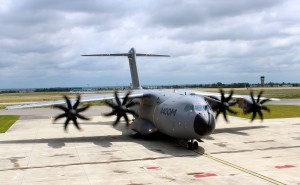5/30/12: By Robbin Laird
I am returning from the two-day event held each year at Airbus Military called the Trade Media Briefing. This one is of course TMB-12.
This year, the trade press started in Madrid and then went to Toulouse to hear presentations on the state of play of Airbus Military aircraft and associated systems as well as to have a hands on tour of the A-400M.
I will provide more detailed looks at the briefings as well as provide some interviews with Asian colleagues who provided insight on various aspects affecting India and Malaysia. My Malaysian colleague provided some very helpful insights on the A400M in Asia as well as his perspective on the recently completed A400M Asian tour.
Here I would like to provide some highlights on what I heard in the presentations, question and answer sessions and in sidebar conversations.
This is more about an emphasis on what I found interesting than purporting to be a summary of the presentations, which as I mentioned above will be coming in the next few weeks.

First, it is clear that CASA has grown significantly beyond its earlier roots and a much broader range of aircraft and systems are being offered. But at the same time, because of the merger of historical legacy and new systems – the A400M and the A330 tanker – the result is a company with a much broader gamut of systems than any other airlift and tanking company in the world.
Going forward in an epoch of unbalanced economic growth and uncertainty about the ability of global customers to buy this or that system, the diversity of systems provides an advantage.
For the lower or more specialized end of the market you have the Casa 235 or 295. For those looking to shape a strategic-tactical lifter, there is the A400M and for really the only new multi-mission tanker, there is the A330 tanker.
There is another advantage as well. There is an ability to deal with global currency situation.
I asked one of the presenters this question: What will be the impact of the Euro crisis on the currency situation for Airbus Military as it seeks global sales?
The answer was an interesting one.
“The CASA aircraft have significant elements built OUTSIDE the Euro zone and are part of the global product. These are dollarized. The A400M and A330 tankers for the moment are largely Euroized, and more affected by currency fluctuations in the Euro zone.”
Again, the inheritance of a legacy product in the portfolio has an advantage in building and sustaining global presence.
Second, the excitement of the Airbus Military team with the near term first delivery to the French Air Force of the A400M was palpable. All that effort, testing and restructuring was now coming to fruition.
And as our small team of TMB-12 participants exited the aircraft and looked up at it, one of the best aviation journalists in the world today just looked at the aircraft and smiled: “It really is quite an aircraft.”
Third, the presentation on training for the A400M, flight and maintenance was developing apace. And as I listened to the presentation, I could not miss the point that there was much in common with the F-35 program.
A core training facility where multi-national crews were being trained, along with maintainers, was a key element of the program and its FLEET approach.
Some of the same technologies and approaches, and most notably, the expectation that the core training facility would be extended to various national centers in the future.
One was reminded of the inherent advantage of multi-nationality built into both programs, with the training, and learning.

And of course, the first pilots and maintainers from initial missions will come back and re-shape training as well.
This is clearly a new day in which multi-nationality and training are combined in an innovative manner.
It would be good if Eglin and Seville got to know each other to share experiences and perhaps technologies.
Fourth, the global aspect of the A400M was also evident in the inclusion of Turkey and Malaysia in the basic European launch program. This will help Airbus Military make sure that it is not too Euro-centric in the shaping of the program going forward, and of course helps extend the meaning of multi-nationality within the program itself.
Fifth, no platform fights alone. It was clear notably with the A400M but also with the A330 tanker that the team is looking at the fleet not just individual platforms.
And from this point of view, the management of the supply chain to build, sustain, and deploy is seen as a single entity.
Global support for a global fleet built from the bottom up in today’s world is different from the old days where global support means warehousing parts locally and moving specialists around via global transport to work with local industry.
Both the F-35 and A400M have common serial numbers and UID built in. This will be a crucial tool going forward.
The A380 has been considered the gold standard for this capability, but a senior Airbus Military official told me, that the A400M is even better than the A380 with regard to the UID and the management of parts.
Sixth, the A330 tanker has an extraordinary capability built-in. The fuel is in the wings, not in the body of the plane.
This allows for the use of the passenger deck, for soldiers, personnel, cargo or medevac.
It also allows for the use of electronics and various other elements for 21st century extended air operations.
As I like to imagine it, the passenger deck can become an innovative space to use for a refueable version of the tanker with a rest area and deployed for a significant period of time. This was certainly what interested the senior USAF leadership when they chose this tanker over the much more limited 767 tanker.
Seventh, the UAE and the Saudis are getting tankers as rapidly as the can, and they are the refuelable version. One does not have to be a genius to ask why.
With the Iranian threat and with missile threats in the region, keeping a flying tanker fleet up in the region, gives the UAE and Saudi Air Forces must greater flexibility in an operational sense, than they would have with a more limited tanker.
Eighth, it is also clear that many of the world’s fleet will use the new Airbus Military products in conjunction with older systems as well. Most notably, there is a huge inventory of Hercules airlifters in the market.
As one of my Asian colleagues commented, “The plan in Asia is not to retire the Hs but to continue to use them as A400Ms are added. Perhaps with the older versions, retirement and replacement is the option.”
This means simply that joint con-ops of A400Ms with C-130s will become a reality and it will be interesting to see how customers use the two of them in tandem and with what effect.
This leads to a simple question with regard to Embraer: Where really is the global market for the KC-390, which is really a Hercules replacement?
There was an amusing sidebar to the visit. The weather was awful, after all one does not expect icing conditions in May in Toulouse and the central heating had been shut off in the Airbus main buildings.
But the test engineer had a different perspective. Tough for you but great for the test community was a clear message.
“Because of the weather we were able to complete our final test in real world icing conditions. This is great!” was the perspective of the head of A400M flight-testing.
A final observation would be about the supply chain. With the upsurge in commercial aircraft production, there is pressure on programs like F-35 and A400M, which rely heavily on commercial aviation supply chains. This means that steady production and clarity in supply is crucial to ensure availability of parts and cost effectiveness.
As the head of the A400M program put it: “There is a significant challenge in managing the supply chain with the upsurge in commercial production which we certainly see every day in Toulouse.”
As an American, it is quite noteworthy that with the all the difficulties of getting Europeans to work together, program delays and various hurdles, that the U.S. procurement process has been even MORE of an impediment than inherent multi-nationality in shaping a product and an approach.
As my friend and colleague, Ed Timperlake has put with regard to the Super Tucano downselect, then cancellation and then whatever, “In a period longer than from Pearl Harbor to D-Day, the USAF could not select an aircraft.”
In short, it was an interesting visit to Madrid and Toulouse. And another phase in aviation history is underway.

